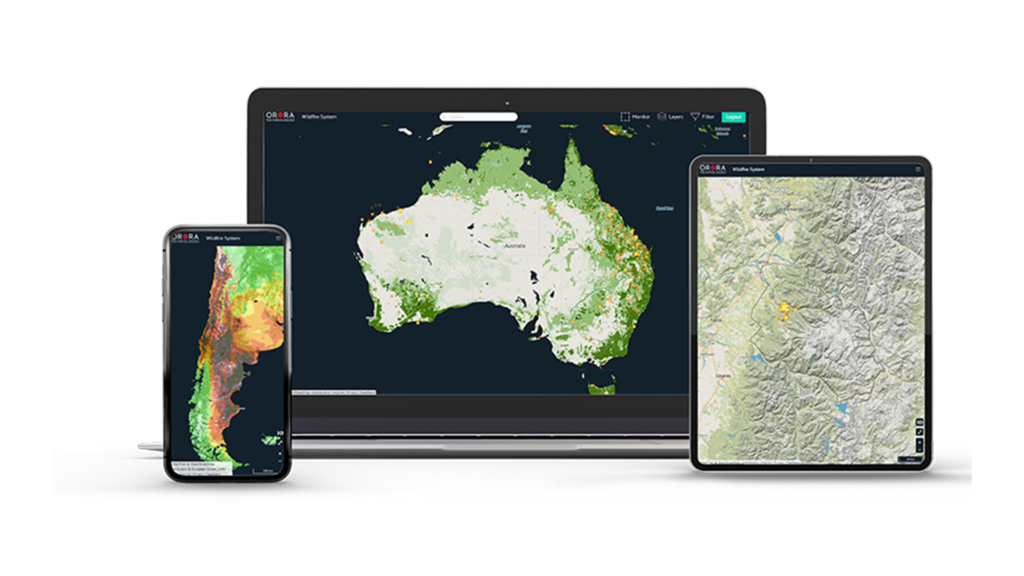
Objectives of the service

OroraTech has developed the first all-in-one global wildfire detection, alerting and monitoring service from space. This service includes risk assessment, early detection, and real-time monitoring. For that purpose, data from existing satellites is aggregated, analyzed, and visualized in the so-called Global Wildfire System (WFS). The WFS is a progressive Web App with near real-time fire and satellite imagery visualization. The system integrates wind speed models, terrain analysis, vegetation data, excelling in comparison to other systems by offering true fire intelligence. Starting as an MPV in 2019, the system has been in pilot operation since early 2020 and is continuously being enhanced following an agile development process with incremental feature updates. OroraTech draws open access to data from the aforementioned space assets. The data is either processed and analyzed by OroraTech’s algorithms to detect wildfires or is already delivered as Hotspot Event Data Sources by third parties.
Users and their needs
Identified potential customers are currently using satellite-based wildfire systems/services provided by public institutions or methods for very localized detection and monitoring of wildfires. All current space-based systems offer only a limited number of satellite sources and limited additional functionality. Due to the aggregation and fusion of 10 additional satellite sources, OroraTech’s WFS can provide superior temporal coverage and functionality for the user compared to e.g., the NASA FIRMS system. The most promising focus segments have been shown to be regional forest and disaster management services (B2G), as well as commercial forestry (B2B). One of the most promising market segments for a later adoption stage is the insurance sector. In the B2G market, the customer’s need is to prevent human fatalities, next to economic damages, environmental impact through a loss of flora, fauna, recreational areas, and the reduction of GHG emissions. Potential B2G customers can be identified on the supranational level, national/country, and regional/state (forest and wildfire management services). For the private sector (B2B market), the most relevant issues are direct damages to assets, uncertainties through disruptions of supply chain activities, and indirect costs through lawsuits for causing fires.
Service/ system concept
The OroraTech WFS provides timely information about hotspots to emergency service managers and other users globally. The mapping system aggregates near-real-time multi-spectral, hotspot and auxiliary data from various satellite data sources to detect areas producing high levels of infrared radiation to allow users to identify potential fire locations. This data is fused within our cloud-based platform and displayed through a web interface for desktop and mobile devices.
One of OroraTech's Wildfire System (WFS) unique features is the ability to track the temporal evolution of heat sources using data points from multiple hotspot sources. The clustering process collects nearby fire events into a single fire cluster and follows this fire cluster by adding more fire events to it as newer observations are made. Thus, enabling the system to track how a fire spreads over time. Clustering is performed as the last step of a complete data processing graph.
Space Added Value
Data from 14 existing satellites is currently aggregated, analyzed, and visualized in OroraTech’s Global Wildfire Service (WFS). Starting December 2021, OroraTech plans to launch its own CubeSat constellation to guarantee a higher temporal resolution in the future.
Current Status
Since the beginning of the KickStart activity, we’ve conducted more than 50 interviews with our key users and partners. The team also created an interview guideline to collect pilot customers’ feedback systematically.
We used the existing Global Wildfire Service (WFS) with its service description and architecture concept as a starting point to implement new features and update the corresponding service description for our customers and partners. Updates focused for example on improvements for clustering of geostationary satellite detections and detections from low-earth orbit satellites to provide notifications for both these satellite types, whose integration was a highly requested customer feature. Furthermore, bugs were fixed as well as existing features improved (e.g., new help menu, improved fire classification system, improved weather overlays). Furthermore, the Software Team also defined the service and system architecture. The Business Development Team revised and updated the existing competitor analysis and started with intense market research. Additionally, the team identified funding possibilities for a future follow-on activity.



